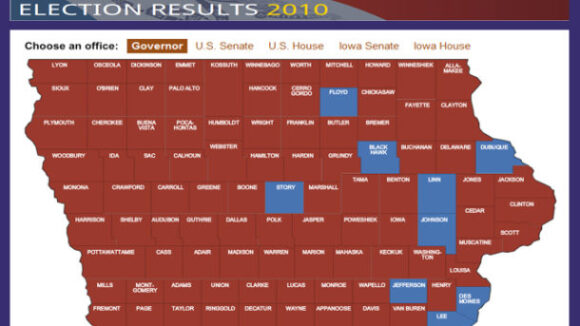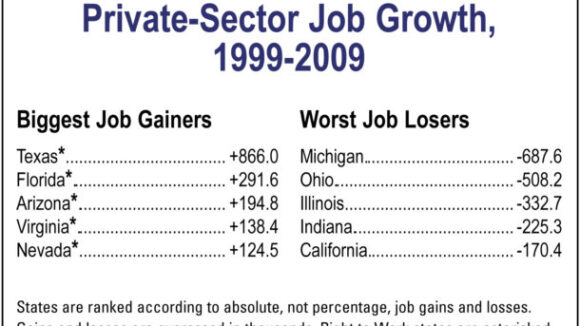Politician's Parting Gift for Taxpayers
On the way out the door, Iowa Gov. Chet Culver (D) gave his final gift to Big Labor — a 6% pay raise for government workers during a recession — a raise that will now cost taxpayers nearly…

On the way out the door, Iowa Gov. Chet Culver (D) gave his final gift to Big Labor — a 6% pay raise for government workers during a recession — a raise that will now cost taxpayers nearly…

On the way out the door, Iowa Gov. Chet Culver (D) gave his final gift to Big Labor — a 6% pay raise for government workers during a recession — a raise that will now cost taxpayers nearly…

Right to Work Makes Major Gains in State Legislative Contests (Source: December 2010 NRTWC Newsletter) It takes a lot to convince Iowa citizens to oust a sitting governor. Until this fall, the last time a Hawkeye State chief executive failed to get another term after seeking one was in 1962! But over the past four years, Big Labor Democrat Gov. Chet Culver wore out Iowans' considerable patience. On November 2, he was one of 13 incumbent governors on the ballot across America. Eleven of these incumbents won, but Mr. Culver lost by a hefty 53% to 43% margin. What had Chet Culver done to receive such a harsh rebuke from normally amiable Midwesterners? He tried to gut Iowa's popular Right to Work law -- and he was sneaky about it. After saying nothing about the Right to Work issue during his successful 2006 gubernatorial campaign, Mr. Culver announced, almost as soon as the votes were counted, his support for legislation imposing forced union dues and fees on Iowa workers as a condition of employment. Since Mr. Culver's fellow Democrats controlled substantial majorities in both chambers of the Iowa Legislature that greeted him upon his inauguration in early 2007, it seemed Big Labor's stealthy scheme to bring back forced unionism to the state six decades after it had been banned would succeed. For four years, Gov. Culver tried to help union bosses extract forced fees from workers who choose not to join. But freedom-loving Iowans first thwarted him legislatively and then defeated him at the polls. But the National Right to Work Committee and the Iowans for Right to Work Committee were already mobilizing resistance. Pro-Right to Work Iowan Stopped Forced-Union-Fee Schemes in 2007 and 2009 Even before the new Legislature convened in January 2007, the National Committee began sending out a series of statewide and targeted mailings to members and supporters in Iowa, with a focus on selected House and Senate members in vulnerable seats.

Forced-Unionism State Employment Down by 1.9 Million Since 1999 (Source: April 2010 NRTWC Newsletter) Recently, millions of Americans have been dismayed by reports, based on official U.S. Labor Department Bureau of Labor Statistics (BLS) data, that from 1999 through 2009 our country endured a "lost decade" in private-sector employment. In this context, the term "lost decade" refers to annual BLS statistics showing that in 2009 there were 107.95 million private-sector jobs nationwide, roughly 370,000 fewer than in 1999, when there were 108.32 million. This marks the first time since the Great Depression that an entire decade has gone by with negative net growth in private-sector employment across the U.S. However, some of the 50 states have fared far better than others over the past 10 years. And a review of how each state's job market performed suggests that the U.S. Congress could dramatically improve America's employment prospects for the next decade by adopting one simple change in federal labor policy. Private-Sector Employment in Right to Work States up by 1.5 Million Since 1999 Current federal labor law authorizes and promotes the payment of compulsory union dues and fees as a condition of getting or keeping a job. Under pro-forced unionism provisions in the 1935 National Labor Relations Act (NLRA) and the 1951 amendments to the Railway Labor Act (RLA), an estimated 6.6 million private-sector employees must pay dues or fees to their Big Labor monopoly-bargaining agent, or face termination from their jobs. At the same time, thanks to many years of vigilant efforts by freedom-loving Americans, federal labor law continues explicitly to recognize states' option to protect employees from forced union dues and fees by adopting Right to Work laws. Currently, 22 states have Right to Work laws on the books prohibiting the firing of employees simply for exercising their right to refuse to join or bankroll an unwanted union. A huge majority of the 22 Right to Work states actually experienced net gains in private-sector employment from 1999 through 2009. Overall, private-sector employment in Right to Work states is up by roughly 1.5 million since 1999. Meanwhile, the 28 forced-unionism states collectively endured a "lost decade" in employment growth far more bleak than that of the nation as a whole. In these states, private-sector employment is down by 1.9 million since 1999.

Forced-Unionism State Employment Down by 1.9 Million Since 1999 (Source: April 2010 NRTWC Newsletter) Recently, millions of Americans have been dismayed by reports, based on official U.S. Labor Department Bureau of Labor Statistics (BLS) data, that from 1999 through 2009 our country endured a "lost decade" in private-sector employment. In this context, the term "lost decade" refers to annual BLS statistics showing that in 2009 there were 107.95 million private-sector jobs nationwide, roughly 370,000 fewer than in 1999, when there were 108.32 million. This marks the first time since the Great Depression that an entire decade has gone by with negative net growth in private-sector employment across the U.S. However, some of the 50 states have fared far better than others over the past 10 years. And a review of how each state's job market performed suggests that the U.S. Congress could dramatically improve America's employment prospects for the next decade by adopting one simple change in federal labor policy. Private-Sector Employment in Right to Work States up by 1.5 Million Since 1999 Current federal labor law authorizes and promotes the payment of compulsory union dues and fees as a condition of getting or keeping a job. Under pro-forced unionism provisions in the 1935 National Labor Relations Act (NLRA) and the 1951 amendments to the Railway Labor Act (RLA), an estimated 6.6 million private-sector employees must pay dues or fees to their Big Labor monopoly-bargaining agent, or face termination from their jobs. At the same time, thanks to many years of vigilant efforts by freedom-loving Americans, federal labor law continues explicitly to recognize states' option to protect employees from forced union dues and fees by adopting Right to Work laws. Currently, 22 states have Right to Work laws on the books prohibiting the firing of employees simply for exercising their right to refuse to join or bankroll an unwanted union. A huge majority of the 22 Right to Work states actually experienced net gains in private-sector employment from 1999 through 2009. Overall, private-sector employment in Right to Work states is up by roughly 1.5 million since 1999. Meanwhile, the 28 forced-unionism states collectively endured a "lost decade" in employment growth far more bleak than that of the nation as a whole. In these states, private-sector employment is down by 1.9 million since 1999.

New Forced-Fee Scheme Directly Attacks State Right to Work Law (Source: March 2010 NRTWC Newsletter) For years, the climate for private-sector employees and business owners in Right to Work Iowa has been far superior to that of neighboring forced-unionism Illinois.
Tensions Rise as Union Bosses’ Window of Opportunity Narrows (Source: January 2010 NRTWC Newsletter) In the wake of the November 2006 elections three years ago, Big Labor strategists were confident they had won all the marbles in Iowa. After saying…